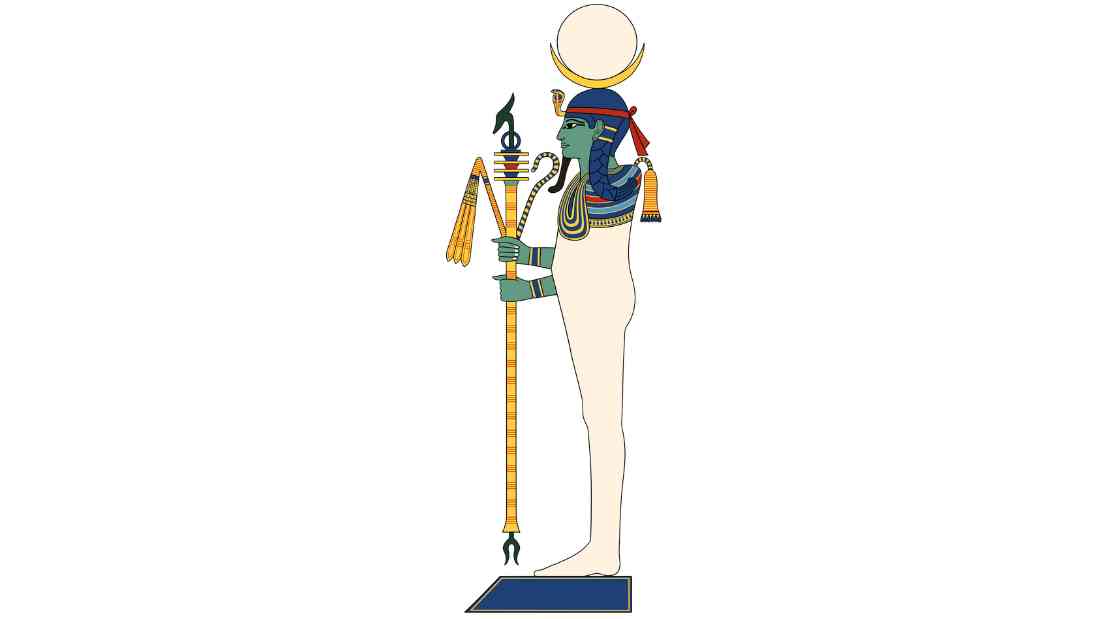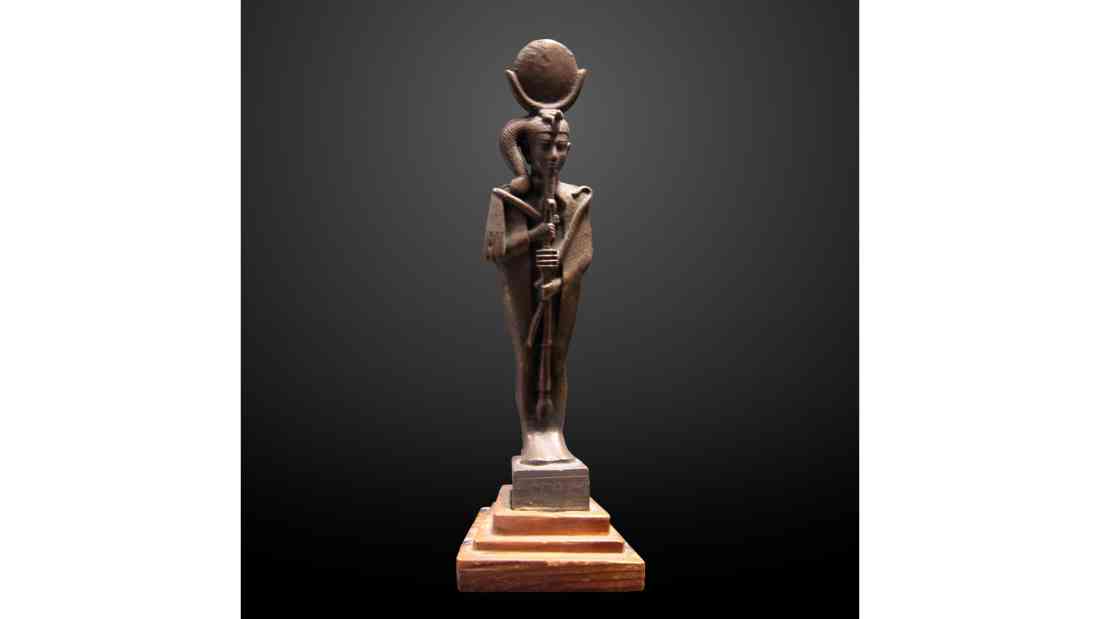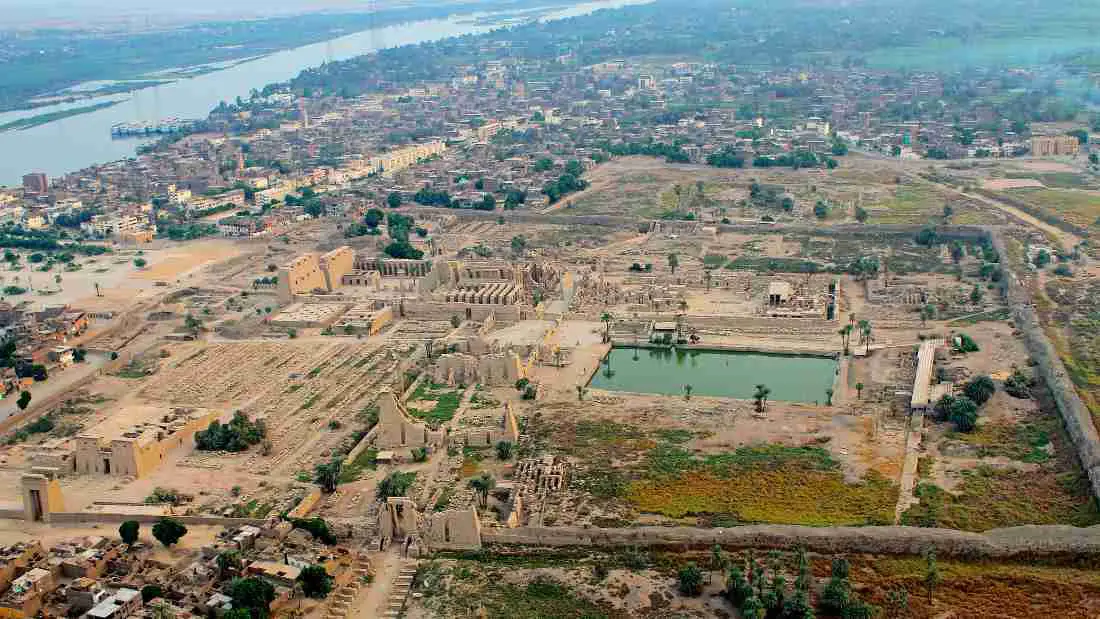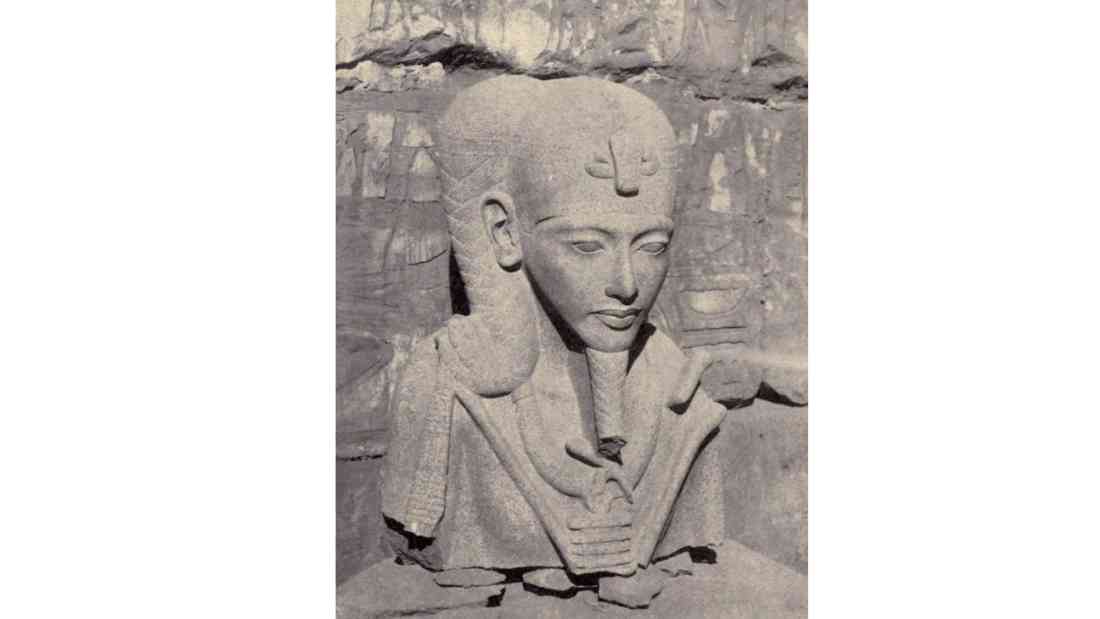Khonsu, also spelled as Chons or Khensu, was one of the important deities in the ancient Egyptian pantheon. He was the Egyptian god of the moon and time. His name means ‘traveller’, signifying the moon’s nightly travel across the sky.

The Representation of Khonsu
In the rich tapestry of ancient Egyptian art and iconography, Khonsu is frequently portrayed as a mummified man.
This depiction is not one of death, but rather symbolizes resurrection and eternity, deeply ingrained concepts in the ancient Egyptian belief system.
His body, wrapped in the traditional style of mummification, reflects the preservation of life after death – a key aspect of Egyptian mythology.
Additionally, Khonsu is often shown with a distinctive sidelock of hair.
This hairstyle carries profound symbolism. The sidelock, known as the “Lock of Youth,” is usually associated with Egyptian child deities, signifying youth, growth, and the potential for renewal and regeneration.
Thus, Khonsu’s sidelock underscores his role in the cyclical processes of time and natural rhythms.
Completing his divine image is a lunar disk headdress. This is a direct reference to his identity as the moon god.
The disk, which mirrors the shape of the full moon, is often shown nestled between two crescent moons or atop a crescent, further emphasizing his lunar associations.
Sometimes, the lunar disk is also depicted enveloped by a crescent moon, representing the new moon phase, thereby reflecting the various stages of the moon’s cycle.
Thus, every aspect of Khonsu’s representation – from his mummified form to his lunar headdress – is imbued with symbolic meaning, offering a deeper understanding of his role and significance within the complex system of ancient Egyptian religious beliefs.

The Nightly Journey of Khonsu, The Egyptian God of the Moon
The celestial journey of Khonsu, the ancient Egyptian God of the Moon, is a captivating narrative deeply embedded in the mythology and cosmology of one of history’s most intriguing civilizations.
The Egyptians held a profound belief in a cosmic order known as Ma’at, which mandated the daily cycle of the sun rising in the east and setting in the west, and the moon commencing its journey across the sky each night after sunset.
Khonsu was the divine entity entrusted with this lunar expedition.
However it is important to note that he was much more than a mere lunar deity. He was an ethereal voyager, navigating his moon boat through the night sky, illuminating the darkness with his celestial light.
Khonsu’s nightly journey bore profound symbolism and significance in the spiritual and daily lives of the ancient Egyptians. The moonlight that Khonsu provided was believed to possess protective qualities, acting as a shield against malevolent spirits and ensuring the safety of travelers venturing out after sundown.
Moreover, Khonsu’s journey wasn’t just about lighting up the night sky. It also represented the natural cycles of life, death, and renewal.
The waxing and waning of the moon, as observed by the Egyptians, were seen as symbolic of rebirth and regeneration. This aligned perfectly with their belief in the cyclical nature of life and death, further enhancing Khonsu’s importance and relevance.
Ancient Egyptians also saw Khonsu as a god who measured the passage of time. The predictable cycle of the moon phases provided a reliable measure for tracking time and determining important dates, further establishing Khonsu’s role as a celestial timekeeper.
Khonsu and Astronomy
Ancient Egyptians were not just builders of pyramids and creators of hieroglyphs. They were also avid astronomers.
Their keen observation of celestial bodies, particularly the moon, played a significant role in shaping their religious beliefs and daily lives.
In this cosmic theatre, Khonsu, the Egyptian God of the Moon, held a pivotal role.
As custodian of the moon, Khonsu was intrinsically linked with the rhythm of the night sky and the science of astronomy.
The Egyptians had developed a lunar calendar that closely tracked the phases of the moon. This calendar served as an essential tool for marking time and determining significant dates such as religious festivals and agricultural activities.
As the moon traversed the night sky, Khonsu’s movements were meticulously observed and recorded. His journey was not just a celestial spectacle but a means to order life on earth.
The moon’s phases – the transitions from new to full moon – were seen as reflective of Khonsu’s own lifecycle.
Just as the moon grows from a thin crescent to a full disk, Khonsu was believed to mature from a young god to an adult deity.
This mirrored the moon’s monthly cycle and symbolized the continuous cycle of growth, decay, and renewal—a core tenet of ancient Egyptian beliefs.
Intriguingly, the Egyptians also had interpretations for celestial events like lunar eclipses.
They believed that during a lunar eclipse, when the moon disappears from the sky, Khonsu embarked on a journey to the underworld.
This interpretation reflects the Egyptian concept of the afterlife, which was a central part of their cosmology. It further underscored Khonsu’s status as a traveller, navigating not just the earthly sky but also the realms of the afterlife.
Temples Dedicated to Khonsu
In ancient Egypt, temples were not just places of worship, but also the dwelling places of the gods. These sacred structures served as a physical connection between the earthly realm and the divine world.
The most prominent temple dedicated to Khonsu is located within the grand religious complex of Karnak, near Luxor in modern-day Egypt.
Karnak, one of the largest temple complexes in the world, was primarily dedicated to Amun, the king of the gods. However, within its vast precincts, there are separate temples devoted to his wife, Mut, and their son, Khonsu.

The Temple of Khonsu at Karnak is an impressive structure, showcasing the architectural prowess of the ancient Egyptians.
Constructed during the reign of Ramses III in the 12th century BC, the temple is noted for its intricately carved reliefs and inscriptions that adorn its walls and columns. These depictions provide valuable insights into the religious beliefs and practices associated with Khonsu.
The temple’s layout follows the traditional design of Egyptian temples, with each section symbolizing a stage in the journey from the mortal world to the divine realm.
The temple begins with a large pylon gateway, leading to an open courtyard. This, in turn, leads to a columned hall, known as a hypostyle hall, before reaching the innermost sanctuary where the statue of Khonsu would have been housed.
In addition to the Temple of Khonsu at Karnak, there were smaller shrines and chapels dedicated to Khonsu throughout ancient Egypt. These reaffirmed Khonsu’s prominence in the Egyptian pantheon and his integral role in their cosmological understanding.
Final Thoughts on the Egyptian God of the Moon
The captivating narrative of Khonsu, the ancient Egyptian god of the moon, provides a compelling window into the celestial beliefs and cosmological understanding of one of history’s most fascinating civilizations.
His nightly journey across the sky was not merely an astronomical phenomenon but a symbolic voyage imbued with deep spiritual significance.
Khonsu’s role as a celestial voyager, illuminating the night sky, underscores the Egyptians’ profound respect for the natural world and its rhythms. They recognized the moon’s crucial role in marking time, guiding navigation, and influencing natural phenomena.
The nightly journey of the Egyptian god of the moon is a testament to the Egyptians’ sophisticated understanding of astronomy, their profound spiritual beliefs, and their enduring quest to find meaning in the cosmos.

Frequently Asked Questions About Khonsu, the Egyptian God of the Moon
Khonsu is a deity in ancient Egyptian mythology known as the god of the moon. His name, which translates to “traveller,” reflects his nightly journey across the sky.
Khonsu is often depicted as a mummified man with the sidelock of youth, indicating his association with the moon’s waxing and waning phases. He is also frequently shown wearing a headdress with a lunar disk, embodying his role as the moon god.
Khonsu played a crucial role in ancient Egyptian cosmology. As the god of the moon, he was responsible for the moon’s nightly journey across the sky. The Egyptians believed that his movements helped mark time and determine significant dates.
Posts About the Egyptian Pantheon of Gods
The Pantheon of Ancient Egyptian Gods – A Comprehensive Guide
The Wrath of Montu – The Mythology of the Egyptian War God
Egyptian God Ammit – The Eater of Hearts in Ancient Egyptian Mythology
The Nightly Journey of Khonsu – The Ancient Egyptian God of the Moon
Ihy – The Joyful Ancient Egyptian God of Music
Min – The Ancient Egyptian God of Fertility
The Egyptian God Anubis – His Evolution from Son of Ra to Protector of the Dead
Unraveling the Mysteries of Babi – The Ancient Egyptian Baboon God
Ra, the Egyptian Sun God – Symbolism and Significance in Ancient Egyptian Culture
Sobek: The Ferocious Crocodile God of Ancient Egypt
The Enigmatic Mythology of Horus, the Egyptian Sky God
The Egyptian God Set – Protector of the Desert and Lord of Conflict
The Ancient Egyptian God Medjed: The Guardian of Osiris and the Afterlife
Anput, the Wife and Female Version of Anubis
Selket – The Scorpion Crowned Egyptian Goddess
Shu – The Egyptian God of Air, Wind, Peace and Lions
Hapi the Androgynous Ancient Egyptian God of the Nile
The Egyptian Sky Goddess Nut: Myth and Symbolism
The 42 Laws of Maat: The Moral Principles of the Ancient Egyptians
The Ancient Egyptian Goddess Mut: The Maternal Power in Egyptian Mythology
The Warrior Goddess: Neith in Ancient Egyptian Mythology
The God Bes: The Joyful Dwarf Deity in Ancient Egyptian Culture
The Egyptian Gods of Love: Hathor and Isis in Ancient Egyptian Mythology
Confronting the Serpent: The God Apep, the Nemesis of Ra in Egyptian Myth

